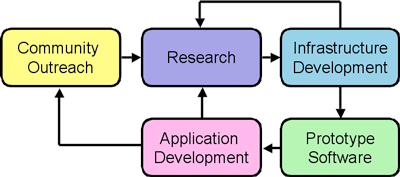The Department of Energy’s (DOE) Office of Science is deploying leadership computing facilities, including a Blue Gene/P system at Argonne National Laboratory and a Cray XT system at Oak Ridge National Laboratory, with the aim of catalyzing scientific discovery. These emerging systems composed of tens of thousands of processor cores are beginning to provide immense computational power for scientific simulation and modeling. However, harnessing the capabilities of such large-scale microprocessor-based, parallel systems is daunting for application developers. A grand challenge for computer science is to develop software technology that simplifies using such systems.
To help address this challenge, in January 2007 the Center for Scalable Application Development Software (CScADS)1 was established as a partnership between Rice University, Argonne National Laboratory, University of California – Berkeley, University of Tennessee – Knoxville, and University of Wisconsin – Madison. As part of the DOE’s Scientific Discovery through Advanced Computing (SciDAC) program, CScADS is pursuing an integrated set of activities that aim to increase the productivity of DOE computational scientists by catalyzing the development of software tools and libraries for leadership computing platforms. These activities include workshops to engage the research community in the challenges of leadership-class computing, research and development of open-source software, and work with computational scientists to help them develop codes for leadership computing platforms.

Figure 1 illustrates the relationships between the Center’s activities. The flow of ideas originates from two sources: workshops for community outreach and vision-building, and direct involvement with application development. These activities focus research efforts on important problems. In turn, research drives the infrastructure development by identifying capabilities that are needed to support the long-range vision. Infrastructure feeds back into the research program, but also supports prototyping of software tools that support further application development. Finally, experiences by developers using prototype compilers, tools and libraries will spur the next cycle of research and development.
First, we briefly describe each of the Center’s activities in a bit more detail. Then, we describe the themes of CScADS research. Finally, we conclude with a brief discussion of ongoing work.






